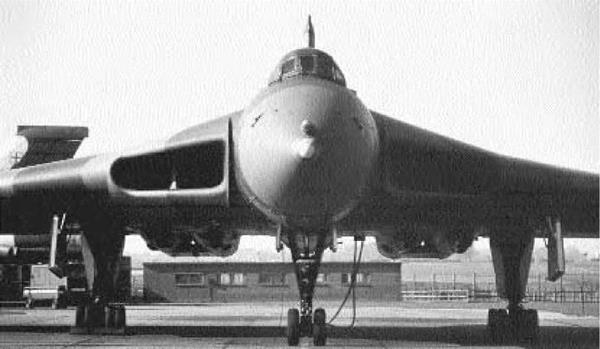Avia B 534
|
Czechoslovakia |
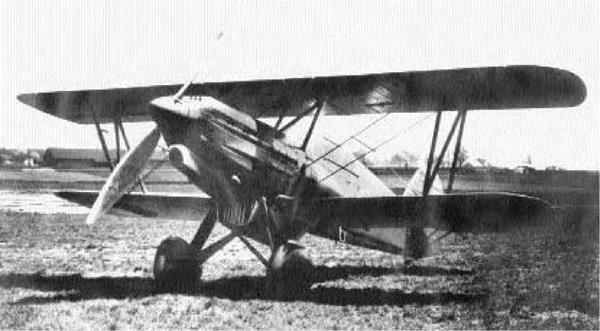
Type: Fighter
Dimensions: wingspan, 30 feet, 10 inches; length, 26 feet, 10 inches; height, 9 feet, 2 inches Weights: empty, 3,218 pounds; loaded, 4,365 pounds
Power plant: 1 x 850-horsepower Hispano-Suiza 12Ydrs liquid-cooled in-line engine Performance: maximum speed, 245 miles per hour; ceiling, 34,875 feet; range, 360 miles Armament: 4 x 7.92mm machine guns Service dates: 1934-1944
|
T |
he beautiful Avia B 534 epitomized the very best of biplane technology. Although fast and maneuverable, it could not compete with modern monoplane fighters under development.
In 1932 the Avia firm under designer Frantisek Novotny substantially revised and updated its B 34 biplane fighter. Within a year a prototype emerged as the B 534, a machine as elegant in appearance as it was splendid in performance. Structurally, the B 534 was a single-bay biplane with wings of unequal length and highly staggered. Ailerons were placed on both the upper and lower wings to enhance maneuverability, while the whole craft was made of steel spars covered in fabric. The fuselage was streamlined and fitted with a beautifully wrought, close-fitting engine cowling. Moreover, it was heavily armed, mounting four machine guns. Two of these were originally wing-mounted, but when trials revealed unacceptable vibration when fired, they were relocated to the fuselage. The prototype was also fitted with a traditional open canopy, but subsequent production models were fully enclosed. Suf
fice it to say that the Czechoslovakian Army Air Force now possessed the fastest, most maneuverable biplane fighter on the continent.
The B 534 was delightful to fly, fast, and responsive to controls. At the 1937 Zurich International Flying Meet, it dominated all events and categories until pitted against Germany’s landmark monoplane fighter, the Messerschmitt Bf 109. Against this new breed of warrior, the Avia finished a close second, but the eclipse of biplane fighters was at hand. These craft might have put up tremendous resistance in 1938 when the Germans occupied western Czechoslovakia, but events transpired without a shot. A total of 446 Avia B 534s thus passed into German hands, and they were employed by the Luftwaffe as trainers and target tugs. Others were also similarly accorded to the puppet Slovak Air Force, which accompanied Hitler’s 1941 invasion of the Soviet Union. Indifferently flown by unsympathetic pilots, they failed to distinguish themselves. A handful of B 534s eventually flew against Germany during the Slovak revolt of 1944.
![]() Austria-Hungary/Germany
Austria-Hungary/Germany
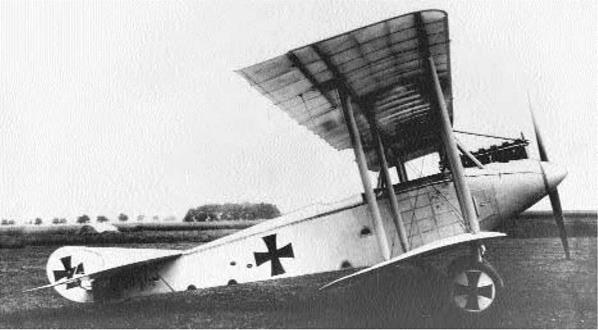
Type: Reconnaissance
Dimensions: wingspan, 27 feet; length, 22 feet; height, 7 feet, 6 inches
Weights: empty, 1,440 pounds; gross, 2,152 pounds
Power plant: 1 x 160-horsepower Mercedes liquid-cooled engine
Performance: maximum speed, 111 miles per hour; ceiling, 8, 200 feet; range, 280 miles
Armament: 1 x 7.62mm machine gun; 40 pounds of bombs
Service dates: 1914-1918
|
T |
he Aviatik series was mediocre and quickly withdrawn from the Western Front during World War
I. However, the long range and dependability of these aircraft enabled them to serve in secondary theaters with distinction.
Following the onset of hostilities in August 1914, the Automobil und Aviatik AG company of Leipzig, Germany, commenced production of two – seat reconnaissance machines based upon its prewar P.15A models. An Austrian subsidiary, Osterreichis – che-Ungarische Flugzeugfabrik Aviatik of Vienna, also brought out slightly modified forms of the same craft. The first series, known as the Aviatik B I, was a conventional, fabric-covered, two-bay biplane with a slightly longer upper span. These craft were unusual in having the pilot placed in the rear seat while the gunner occupied the front. This seemingly absurd arrangement appreciably interfered with the latter’s field of fire while also obstructing the pilot’s view. Nonetheless, in the early days of aerial conflict, the long range and pleasant flying characteristics of the Aviatik made it popular with crews. It was also one
of the few two-seaters that could be rigged with bombs for harassment raids. Two subsequent versions, the B II and B III were introduced with more powerful engines and more conventional seating. These machines could fly nearly half again as fast and as high as the first model, but by 1916 they suffered heavily at the hands of improved Allied fighters. Moreover, they were aerodynamically less stable than earlier versions. The Germans eventually deemed them unacceptable for the Western Front.
In an attempt to upgrade the performance of Austrian aircraft, a new version, the C I, was introduced in 1915. Modifications included a new 160- horsepower Mercedes engine, an exhaust stack piped over the top wing, and a streamlined spinner. However, this model reverted back to the awkward arrangement of placing the pilot in the rear seat, a feature corrected again in the subsequent C III model. For want of a better replacement, they remained in Austrian service on the Italian and Russian fronts up through the end of the war. A total of 167 C models were constructed.
![]() Austria-Hungary
Austria-Hungary
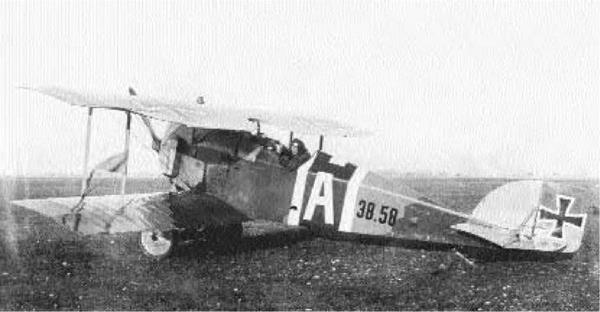
Type: Fighter
Dimensions: 26 feet, 3 inches; length, 22 feet, 9 inches; height, 8 feet, 1 inch
Weights: empty, 1,345 pounds; gross, 1,878 pounds
Power plant: 1 x 200-horsepower Daimler liquid-cooled in-line engine
Performance: maximum speed, 115 miles per hour; ceiling, 20,177 feet; range, 250 miles
Armament: 2 x 7.92mm machine guns
Service dates: 1917-1918
|
T |
he “Berg Scout” was the first fighter designed and mass-produced in Austria. Although fastclimbing and maneuverable, it was distrusted by pilots because of a reputation for frailty.
In the fall of 1916, the Osterreichische-Un – garische Flugzeugfabrik Aviatik of Vienna began constructing a single-seat version of its two-seater C I machine. The chief designer, Julius von Berg, incorporated many features of the previous model into the new craft, which became known as the “Berg Scout.” The D I was a conventional biplane fighter with slightly staggered, single-bay wings. However, the fuselage was very deep, leaving only the pilot’s head exposed. This provided considerable shelter against the elements but interfered with forward vision. Worse yet, the D I was armed with a single machine gun mounted on the top wing that fired above the propeller arc at an angle. Thus situated, pilots enjoyed clear shots only while diving upon a target. However, the D I was light and, propelled by a 185-horsepower Daimler motor, climbed like a rocket. It entered production in the spring of
1917 and joined the ranks of the hard-pressed Luft – fahrtruppe (Austrian air service) that fall.
In service many pilots expressed displeasure with the D I’s performance. Flight tests demonstrated that it could outclimb and outturn the Austrian-built Albatros (Oef) D III with ease, but several machines crashed after structural wing failures. Moreover, the new 200-horsepower Daimler engines were powerful but prone to overheating. An entire series of experimental radiators was eventually fitted, but these only further obstructed the already cramped front view. In an attempt to up-gun the D I, a pair of machine guns was also fitted with interrupter gear that fired through the propeller arc, but these were placed so far forward that pilots could not unjam them by hand. Despite long-standing deficiencies in the machine, Austrian pilots eventually adapted to the “Berg Scout,” and it rendered respectable service against a host of Italian and Russian aircraft. Production orders totaled 1,200 aircraft, but only 700 had been delivered by the time of the Armistice.
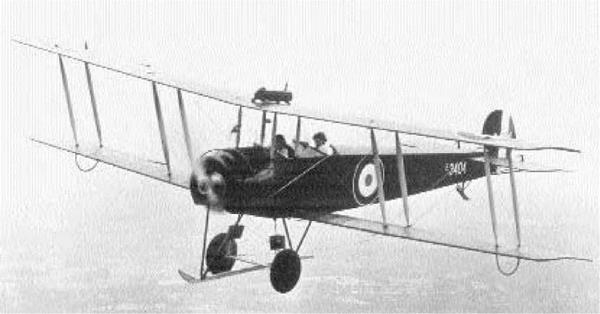
Type: Reconnaissance; Light Bomber; Fighter; Trainer
Dimensions: wingspan, 36 feet; length, 29 feet, 5 inches; height, 10 feet, 5 inches Weights: empty, 1,240 pounds; gross, 1,800 pounds Power plant: 1 x 100-horsepower Gnome Monosoupape rotary engine Performance: maximum speed, 82 miles per hour; ceiling, 10,000 feet; range, 250 miles Armament: usually none, or 1 x.303-inch machine gun; up to 80 pounds of bombs Service dates: 1913-1933
|
T |
he gangly Avro 504 rates as one of the greatest airplanes ever. In a career spanning two decades it underwent many modifications and trained generations of pilots.
In 1913 Alliot Verdon Roe, a pioneer of tractor – propelled airplanes, demonstrated his latest creation, a rather modest-looking craft called the Avro 504. It was a standard two-seater biplane with four – bay wings and a large skid protruding from its landing gear. It was also immensely strong and exhibited docile handling qualities once airborne. Both the Royal Flying Corps and the Royal Navy ordered several copies on the eve of World War I. Not surprisingly, Avro 504s were among the many reconnaissance aircraft dispatched to France, and on August 22, 1914, one received the dubious distinction of becoming the first British airplane lost in combat. The Royal Navy, fortunately, had outfitted their 504s as light bombers, and on November 21, 1914, four of the little biplanes launched a daring and devastating
raid upon the Zeppelin hangars at Friedrichshafen. During the course of the war, this handy craft received several modifications and one, the K version, was a single-seat fighter employed by home defense units until 1918!
However, it was as a trainer that the Avro 504 found its niche in aviation history. Commencing with the J model of 1916, it trained thousands of British and Allied pilots, including Prince Albert, the future King George VI. Moreover, it was the machine of choice at the famous School of Special Flying at Gosport. There the famous Major R. R. Smith-Barry used 504s to initiate his new and standardized system of flight instruction. After the war, it remained in production up through 1927 and was fitted with a bewildering variety of power plants. A total of 8,970 Avro 504s were built in England, with another 2,000 constructed in the Soviet Union. These remained in frontline service with the Royal Air Force until 1933 and flew many years thereafter with private owners.
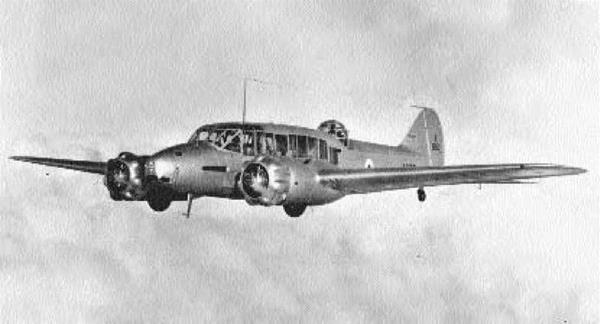
Type: Reconnaissance; Trainer
Dimensions: wingspan, 56 feet, 6 inches; length, 42 feet, 3 inches; height, 13 feet, 1 inch
Weights: empty, 5,375 pounds; gross, 9,900 pounds
Power plant: 2 x 420-horsepower Cheetah XV radial engines
Performance: maximum speed, 188 miles per hour; ceiling, 19,200 feet; range, 700 miles Armament: 2 x.303-inch machine guns; up to 360 pounds of bombs Service dates: 1936-1968
|
T |
he venerable Anson was one of the longest-serving types in Royal Air Force history. Ease of flying and great reliability garnered it the nickname “Faithful Annie.”
In 1935 the British Air Ministry invited Avro to develop a twin-engine landplane for reconnaissance purposes. Avro drew upon its Model 652 commercial craft, two of which were sold to Imperial Airways in 1933. The prototype Anson was based upon this aircraft and first flew in 1935. It was a low-wing monoplane of mixed steel-tube, wood, and fabric construction. The fuselage was long and rectangular and sported a conspicuous dorsal gun turret. Having successfully concluded flight tests, Ansons entered service with the RAF in 1936. They were significant in being the first monoplane types accepted into service, and the first British warplane with retractable (if hand-cranked) landing gear. By the advent of World War II in 1939, Ansons equipped no less than 12 squadrons with the RAF Coastal Command. Its all-around utility and docile handling prompted the nickname “Faithful Annie.”
The Anson was marginally obsolete at the commencement of hostilities yet gave a good account of itself before being replaced by Armstrong – Whitworth Whitleys and Lockheed Hudsons. Only two days after the declaration of war in September 1939, one dropped bombs on a U-boat, the first offensive action taken by a Coastal Command aircraft. In June 1940 a trio of Ansons was jumped by nine formidable Bf 109 fighters; the little cluster not only beat off the assailants but also shot down two and damaged a third! By 1942 they were replaced by more modern types, but Ansons continued to perform important work as trainers. Several versions were introduced during the war that instructed thousands of pilots, radio operators, and gunners throughout commonwealth air forces. Ansons remained in production until 1952; 11,020 had been constructed in Great Britain and Canada. The last six British aircraft served as communications aircraft until mustering out with great ceremony in
1968.
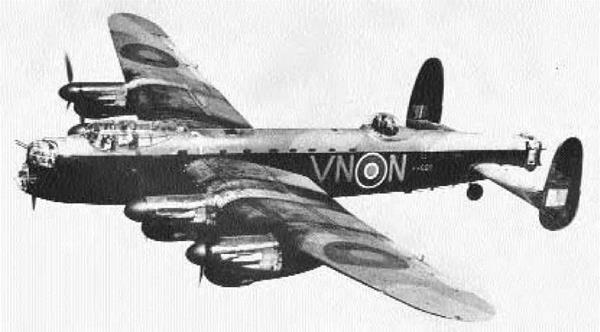
Type: Heavy Bomber
Dimensions: wingspan, 102 feet; length, 69 feet, 6 inches; height, 20 feet Weights: empty, 36,900 pounds; gross, 68,000 pounds
Power plant: 4 x 1,460-horsepower Rolls-Royce Merlin XX liquid-cooled in-line engines Performance: maximum speed, 287 miles per hour; ceiling, 24,500 feet; range, 660 miles Armament: 8 x.303-inch machine guns; up to 2,000 pounds of bombs Service dates: 1942-1954
|
T |
he Lancaster overcame troubled beginnings to become Britain’s legendary heavy bomber of World War II. Fitted with special ordnance, it gained special renown as the “Dam Buster.”
In 1936 the British Air Ministry released Specification P. 13/36 for a new twin-engine medium bomber. Avro originated the Manchester, which was a sound design but powered by totally unreliable Rolls-Royce Vulture engines. Two hundred of these unfortunate craft were built, but all left the service by 1942. However, the machine was refitted with an increased wingspan to accommodate four engines and rechristened the Lancaster. Thus was born the outstanding British night bomber of World War II. The Lancaster was an all-metal, high-wing monoplane with dual rudders. The fuselage was an oval-shaped, monocoque construction with a cavernous bomb bay extending half the length of the fuselage. This capacious feature could carry a variety of explosive and incendiary devices. The big bomber was rushed into production, with many Manchesters being converted while still on the production line. The new bomber commenced operations over Germany in March 1942, and within a
year Lancasters largely supplanted the Handley Page Halifaxes and Short Stirlings as the backbone of RAF Bomber Command. They proved instrumental in implementing the Royal Air Force policy of nighttime saturation bombing of German cities and industrial centers.
Lancasters distinguished themselves in the evening skies over Europe by delivering 608,612 tons of bombs in 156,000 sorties. However, they are best remembered for two very special attacks. The first, launched against the Mohne and Eder dams on May 17, 1943, utilized the famous Barnes Wallis “skipping bomb” that demolished its targets. The second fell upon the German battleship Tirpitz in Norway. On November 12, 1944, 31 Lancasters armed with 12,000-pound “Tallboy” bombs finally sank the dreaded raider in a fjord. By war’s end, Lancasters had been modified to carry the 22,000- pound “Grand Slam” bomb. Many subsequently joined the RAF Coastal Command and performed maritime reconnaissance work until 1954. A total of 7,377 were built, and a handful remained in Canadian service until 1964.
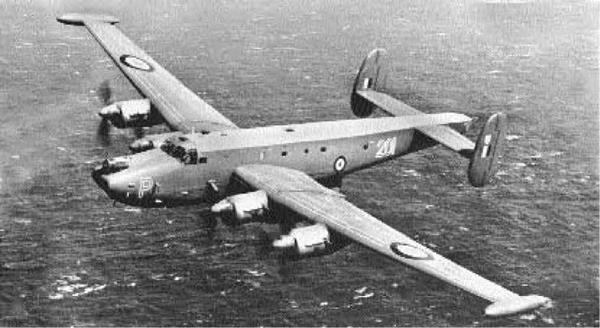
Type: Patrol-Bomber; Early Warning
Dimensions: wingspan, 120 feet; length, 87 feet, 4 inches; height, 16 feet, 9 inches Weights: empty, 57,000 pounds; gross, 98,000 pounds
Power plant: 4 x 9,820-horsepower Roll-Royce Griffon liquid cooled in-line engines Performance: maximum speed, 273 miles per hour; ceiling, 20,000 feet; range, 2,900 miles Armament: 2 x 20mm cannons; up to 20,00 pounds of bombs Service dates: 1951-1991
|
T |
he anachronistic Shackleton was the RAF’s first dedicated maritime patrol-bomber. Fitted with decidedly third-rate radar, it also served as England’s first distant-early-warning aircraft.
The Shackleton can trace its roots to the famous Avro Lancaster through an intermediary type, the Lincoln heavy bomber. In 1946 the Royal Air Force sought to replace its World War Il-vintage patrol-bombers with a completely modern type. A standard Lincoln was accordingly modified into a prototype maritime patrol craft, and the differences were so pronounced that a new designation became necessary. The new Shackleton utilized the same wing and undercarriage as its forebear but employed an all-new fuselage that was narrower and taller. The first MR 1 version did not become operational with the RAF Coastal Command until 1951. The following year the MR 2 appeared with an extended and heavily modified nose section. The final version, the MR 3, finally debuted in 1955. This craft featured a nosewheel, tricycle landing gear, and
fixed wingtip tanks to boost the already impressive cruise range. The dorsal turret was also deleted in favor of additional space, and a clear-view cockpit canopy was fitted. Moreover, to alleviate the strain of extended patrols on the crew, it also possessed such creature comforts as a soundproof wardroom. These durable craft performed well, and all were retired from maritime duties in 1971 by the jet-powered Hawker-Siddeley Nimrod.
Defense cuts in the late 1960s led to the mothballing of several aircraft carriers and, with them, the distant-early-warning Fairey Gannet aircraft. As a completely stopgap effort, 12 of the obsolete MR 2 Shackletons were then dusted off, fitted with the Gannet’s World War II-vintage radar, and employed as the new AEW 2. This was a ramshackle affair at best, but the British government saw fit to employ these flying museum pieces until their replacement by infinitely superior Boeing E-3A Sentries in 1991. Thus ended an aircraft dynasty that had served Britain long and well for nearly half a century.
|
Dimensions: wingspan, 99 feet; length, 97 feet, 1 inch; height, 27 feet, 1 inch Weights: empty, unknown; gross, 200,000 pounds
Power plant: 4 x 20,000-pound thrust Bristol Olympus 301 turbojet engines Performance: maximum speed, 650 miles per hour; ceiling, 60,000 feet; range, 5,750 miles Armament: up to 21,000 pounds of conventional or nuclear weapons Service dates: 1957-1982
|
T |
he hulking Vulcan was the second of Britain’s famous “V” bombers and the first such craft outfitted with a delta wing. Although intended for a possible war with the Soviet Union, it fired its only shots in anger during the 1982 Falklands conflict.
A 1946 British air staff study recommended production of a trio of new strategic bombers that combined high speed, heavy payload, and great range. The Air Ministry then issued Specification B.35/46 to that effect, and an Avro design team under Roy Chadwick came up with a unique solution. They held that a large delta configuration was the best possible solution to all three requirements, especially in providing lift and, hence, range. A prototype of the huge craft was rolled out in August 1952 as the Vulcan. It was a very streamlined airplane, with the air intakes and engines buried within the wing and tricycle landing gear. The design was strong enough to be rolled in flight, and the prototype exhibited fighterlike qualities. The only major problem encountered was buffeting at high speeds,
which was corrected on production models by providing a kinked leading edge and a less swept-back wing. The Vulcan B.1 entered the service in 1957, and 45 were constructed. These were followed by 87 of the B.2 model in 1960, which had extensively modified flight-control surfaces and stronger engines. This version was also equipped to fire the nuclear-tipped Blue Steel standoff missile.
The Vulcans served capably in their roles as part of the West’s nuclear deterrent. However, when the Soviet Union finally perfected surface-to-air missile technology, the big bomber’s mission changed from high-altitude bombing to low-altitude penetration. New and better electronic countermeasures were installed, as well as an array of conventional bombs. The Vulcans were due to be phased out early in 1982 but earned a brief reprieve during the Falklands conflict with Argentina of that year, where a handful conducted very long-range bombing missions with mixed results. This memorable bomber’s replacement was the Panavia Tornado.











